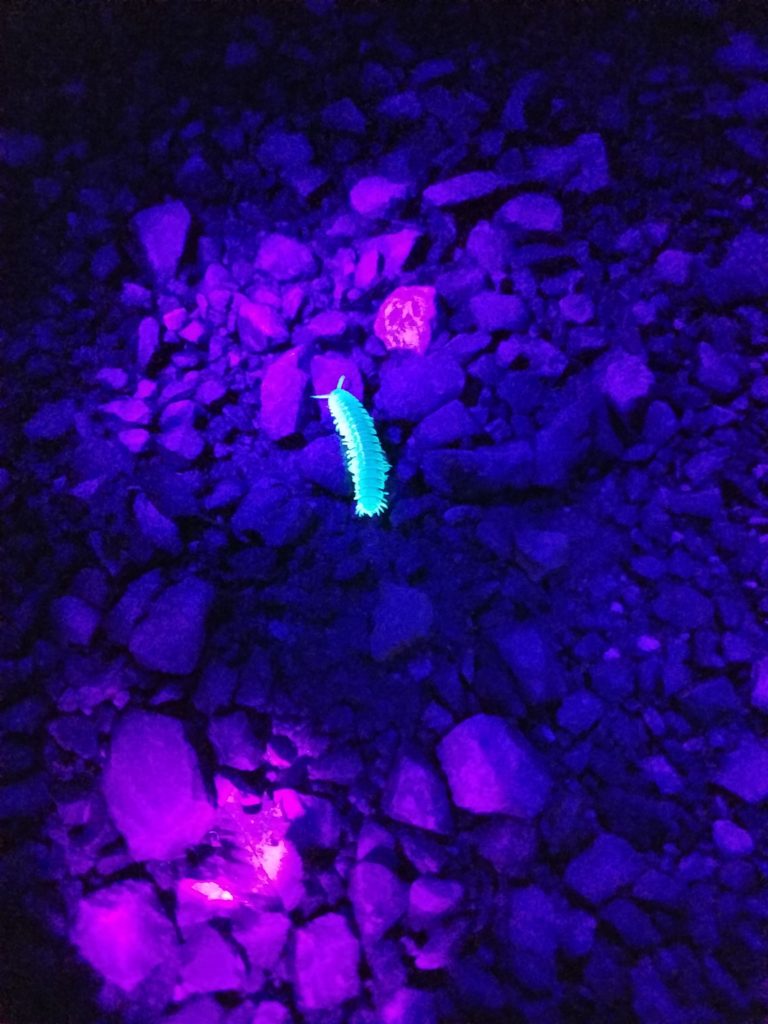
By Sarah Presogna, Environmental Education Specialist Supervisor at Nolde Forest Environmental Education Center. Sarah is a night owl who loves find new and interesting ways to explore the forest after dark.
Fall in the Pennsylvania forest is the time for leaf peeping, marveling mushrooms, and chasing the warblers as they migrate back south. But as the days get shorter, the nights get longer, which limits the activities you can engage in. Or does it? In parks with night programs, a simple black light flashlight can open up a whole new way to see the world!
Objects don’t actually possess color – that is to say, objects do not produce colors on their own. Instead, when light hits an object, the object absorbs some wavelengths of light and reflects the rest. The wavelengths that are reflected bounce off that object and enter our eye. Depending on the size of the wavelength that enters the eye, special photoreceptors called cones send a signal to your brain and combines all the information into a color.
You know the colors of light we can see. But there are wavelengths beyond those colors that are invisible to the human eye. Infrared, for example, is the wavelength just before the color red. We can’t see it, but we feel it as heat. On the other end, just past violet, is ultraviolet (or UV) light. We cannot see this light either, but many animals can, and they use UV markings to attract mates, display to one another, and find food. Imagine what the world would look like if we could see these hidden colors all around us!
So how can black lights let us see in UV when our human eyes can’t see those wavelengths? The reason is an object called a “phosphor.” Phosphors are any substance that emit light when exposed to radiant energy (in this case ultraviolet radiation). You are familiar with them on things like the coating on CRT TV screens or the glow in the dark numbers on your watch.
When a phosphor is exposed to electromagnetic radiation (like a UV flashlight) the electrons in the phosphors absorb the extra energy and jump up to a higher level. Then just as quickly, the energy dissipates, and the electrons move back down to their “normal” state. Since we know energy cannot be created or destroyed, that energy must go somewhere and in the case of phosphors, the energy is converted into visible light. This is known as “florescence.”
 Florescence happens all the time, but the bright light of the sun makes it hard for us to notice. That is why UV flashlights work best at night or in a dark room. So, by hiking in the woods after dark with a UV light, you can be treated to the hidden world that is visible to insects, birds, and fish.
Florescence happens all the time, but the bright light of the sun makes it hard for us to notice. That is why UV flashlights work best at night or in a dark room. So, by hiking in the woods after dark with a UV light, you can be treated to the hidden world that is visible to insects, birds, and fish.
Here at Nolde Forest we have discovered that the Black and Gold Flat Millipede (Apheloria virginiensis) glows a striking blue along its segments when exposed to a UV light. We’ve also found that snakeskin sheds and certain types of fungus light up as well.
What will you find on your adventure?




